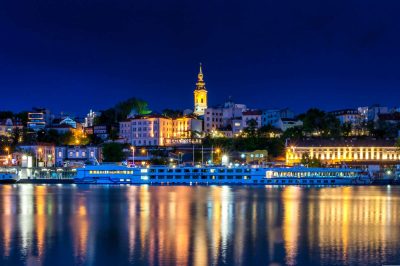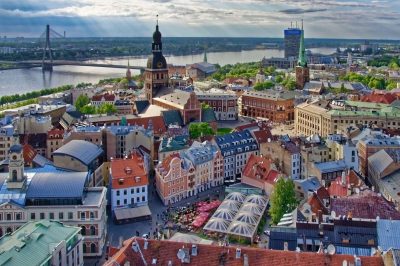Novi Sad is the most important center in the north of Serbia, Vojvodina. The country’s second largest city boasts beautiful churches and a fortress high above the Danube. Novi Sad was European Youth Capital in 2019 and even the first municipality outside the EU to be European Capital of Culture in 2022. Reason enough to introduce you to the “Pearl of Vojvodina” and the most beautiful Novi Sad sights!
The history of Novi Sad
Novi Sad was only founded in the Middle Ages, although there is evidence of settlements in the area dating back to the Neolithic period. In the late Middle Ages, the town belonged to the Kingdom of Hungary and was called Újvidék. In 1526, the town was conquered by the Turks during the Ottoman advance in the Balkans, who pursued a tolerant settlement policy and allowed the settlement of Slavs. In 1694, the Austrians began building a fortress on the opposite bank of the Danube, which they named Peterwardein (Serbian: Petrovaradin).
In the Peace of Karlowitz (the town is located just a few kilometers from Novi Sad), the Ottoman Empire had to cede the entire region to Austria in 1699, and the town was henceforth known as Neusatz. The Austrians subsequently developed the fortress into the largest defensive structure in the Balkans, and a small town was created in which only Catholics were allowed to settle. On the other side of the Danube, where the old town of Novi Sad is located today, the town, also known by Austrians as Ratzenstadt, flourishes.
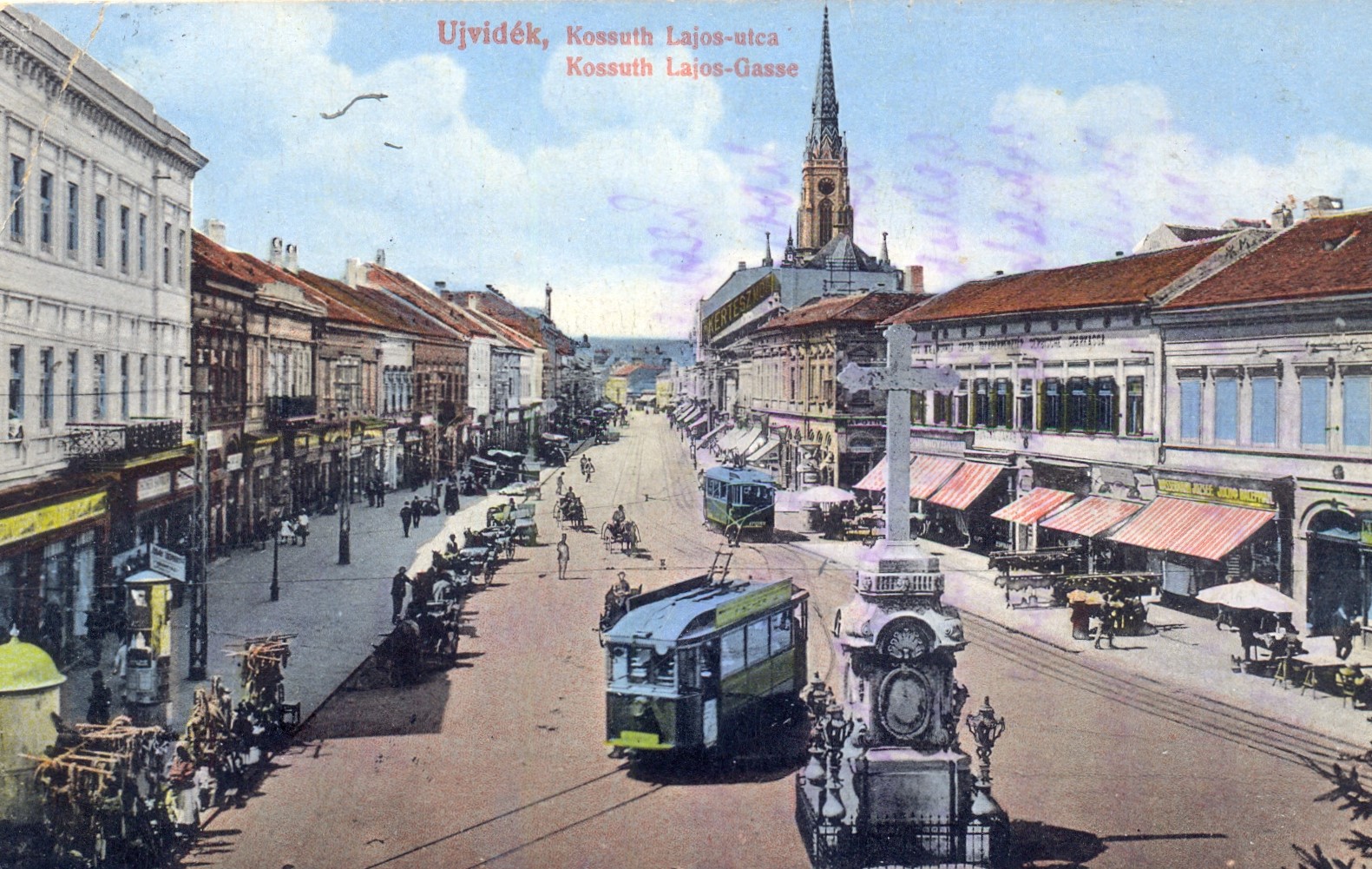
In 1748, Maria Theresa granted Novi Sad the title of Royal Free City, which underlined the special significance of the town. As a result, more and more Serbs settle here and Novi Sad becomes the most important intellectual center of the Serbs and is also known as the “Serbian Athens”. In 1849, the city was attacked by Hungary and badly destroyed. After the end of the Habsburg Empire, Novi Sad became part of the Kingdom of Serbs, Croats and Slovenes and later of the Kingdom of Yugoslavia. During the Second World War, the city is besieged by Hungarians, who carry out a massacre of the Serbian and Jewish population.
After the Second World War and the Communist takeover, Novi Sad becomes the capital of Vojvodina within the Yugoslavian republic of Serbia, Petrovaradin is incorporated and has been part of the city ever since. During the Kosovo War, the city is heavily damaged by NATO bombers and suffers the worst damage of all Serbian cities, including the destruction of all bridges over the Danube. Reconstruction then began. Due to its outstanding historical significance, Novi Sad was awarded the title of “European Capital of Culture” in 2022. But enough preamble, let’s start our visit to the Novi Sad sights!
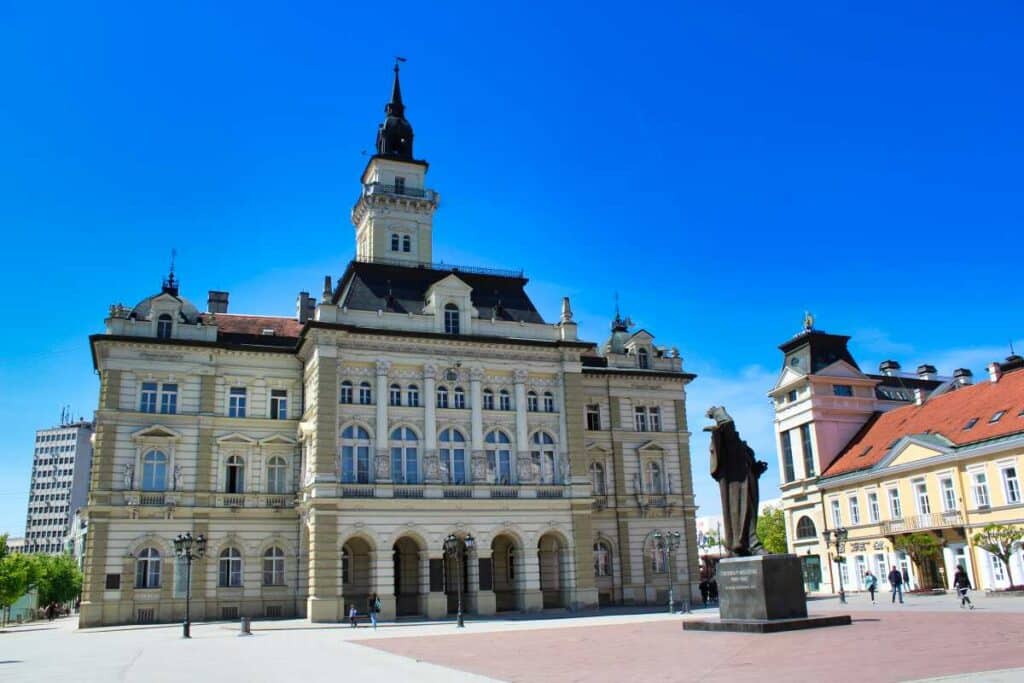
Freedom Square (Trg Slobode)
Freedom Square is the undisputed center of the city, where literally all the threads come together. Some of the most famous Novi Sad sights are located here. It is not so easy to name the most beautiful building on the square. A hot candidate for the title is definitely Novi Sad’s pretty town hall. It was built in 1895 and today forms the south-western end of Trg Slobode.
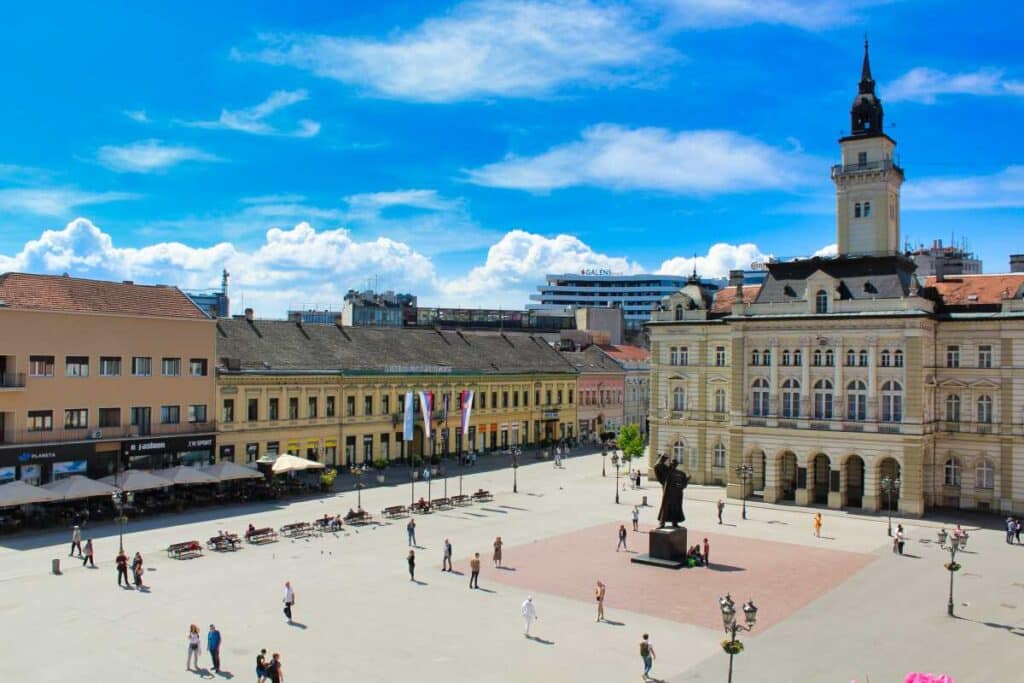
A statue commemorating Svetozar Miletić stands in front of the town hall. He became mayor of the city at a young age and was one of the most important pioneers of the Serbian nation for its rights within the Danube Monarchy; under his aegis, Serbian replaced German as the official language. However, he was not a nationalist, but always strove for reconciliation with other peoples in the empire. The monument was created by Ivan Meštrović, who left his mark in Zagreb in particular, but also in Belgrade.
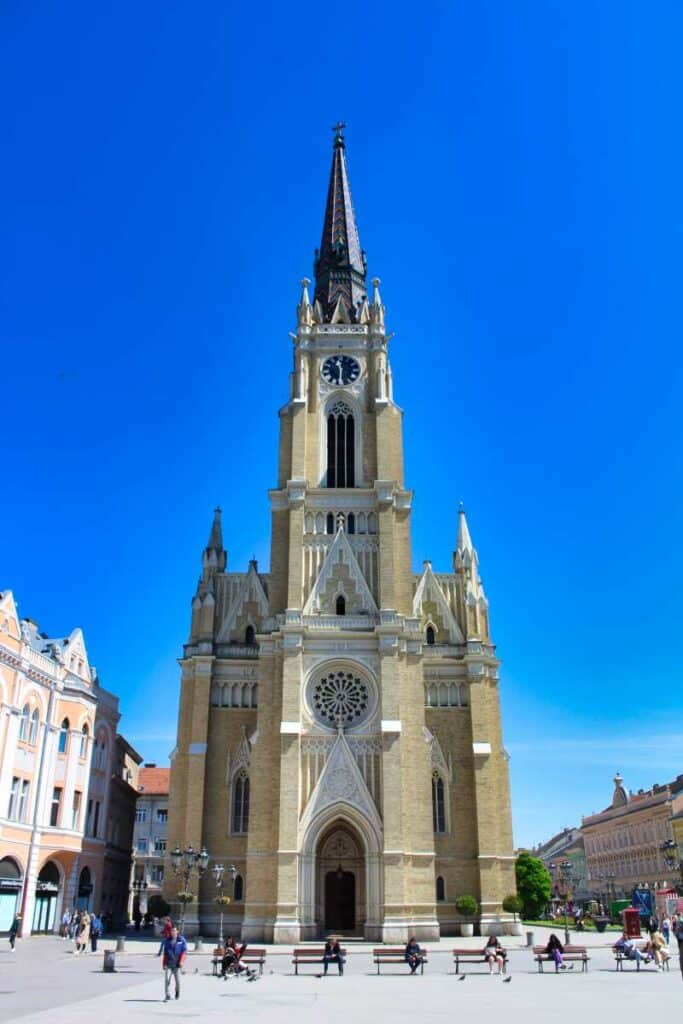
Opposite the town hall is the second important building on the square, the Church of St. Mary (also known as the Church of the Name of Mary or Crkva imena Marijinog). The Catholic church is the largest place of worship in the town. The neo-Gothic church was consecrated in 1895 and is unmistakably reminiscent of its Viennese model, St. Stephen’s Cathedral. It is one of the most important sights in Novi Sad, mainly due to its colorful roof shingles, four artistic altars and numerous stained glass windows.
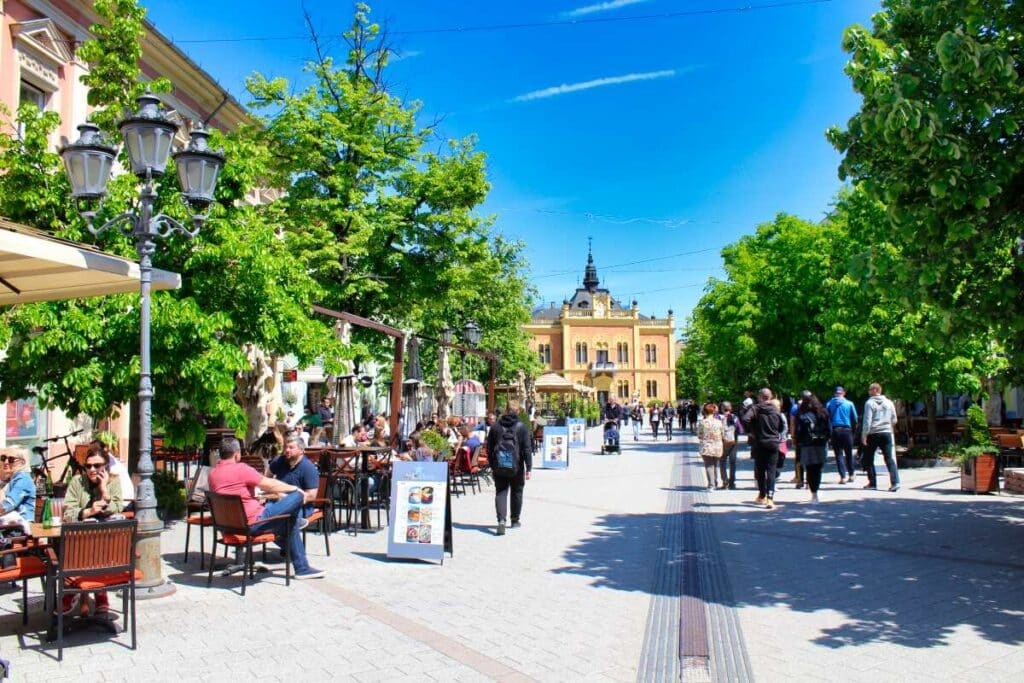
Zmaj Jovina
Starting from Freedom Square, Zmaj Jovina, Novi Sad’s most important pedestrian zone, runs in a north-easterly direction. See and be seen is the name of the game here and the number of chic cafés and restaurants can hardly be quantified. It used to be known as “Main Street”, later it was called “Marshal Tito Street”. Baroque, art nouveau, neo-renaissance and classicist buildings line the street and, despite their different characters, create an extremely atmospheric overall picture. There is always something going on here in summer, especially in the evenings, when the residents of Novi Sad and tourists populate the terraces of the bars and restaurants.

Laze Telečkog
While Zmaj Jovina exudes a certain tranquillity despite its bustle, Laze Telečkog, a side street, is much wilder and the perfect place for night owls in particular to turn night into day in Novi Sad. Countless bars and pubs line the relatively short street, where alternative establishments can be found in many corners and cool street art paintings dominate the scene. You should definitely come as early as possible if you want to get a table outside in good weather!

Bishop’s Palace
The Bishop’s Palace forms the end of Zmaj Jovina and cannot be missed due to its magnificent, recently repainted façade. Although you can’t visit the building, it is still one of the most important Novi Sad sights. Incidentally, the area was not always as chic as it is today, as there was still a swampy area here in the 19th century which, according to contemporaries, must have spread a terrible stench. The palace was built in 1901 and, then as now, it delights onlookers with its exotic-looking exterior, whose decorative elements meander somewhere between oriental motifs, Byzantine echoes and classicist austerity.
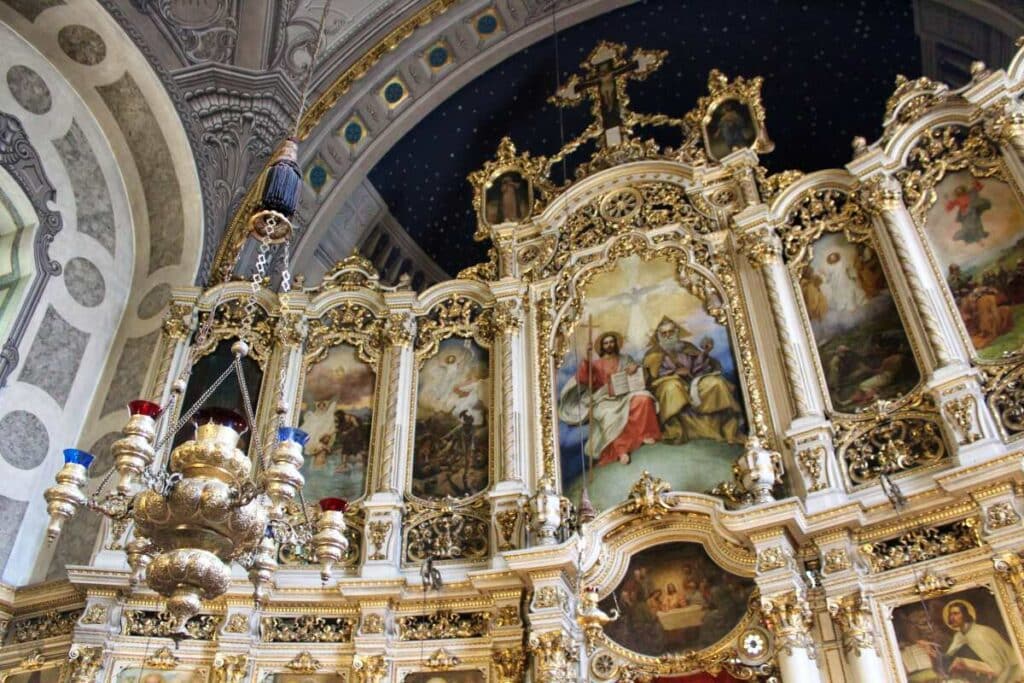
Church of St. George (Crkva Svetog Đorđa)
The city’s most important Orthodox church is located right next to the Bishop’s Palace. The pretty St. George’s Church is a real eye-catcher from the outside, but its true splendor only unfolds inside. It was originally a baroque building from the mid-18th century, but was destroyed by the Hungarians in 1849. The church was built in its current form between 1860 and 1880 and is now the seat of the Eparchy of Bačka.

Museum of Vojvodina (Мuzej Vojvodine)
The quaint Danube Street (Dunavska) with its pretty backyards leads directly to the Museum of Vojvodina, the most important in the city. It is dedicated to the region’s eventful past. Starting with archaeological finds from the Neolithic period, it spans from the Middle Ages to modern times. It not only focuses on the history of the Serbs, but also on the religious and ethnic groups that once lived here. Highlights include a collection of magnificent Roman helmets, the bishop’s carriage from the 18th century and a replica of a typical Novi Sad street from around 1900. Life in the town and countryside in times gone by is also well presented thanks to numerous exhibits.
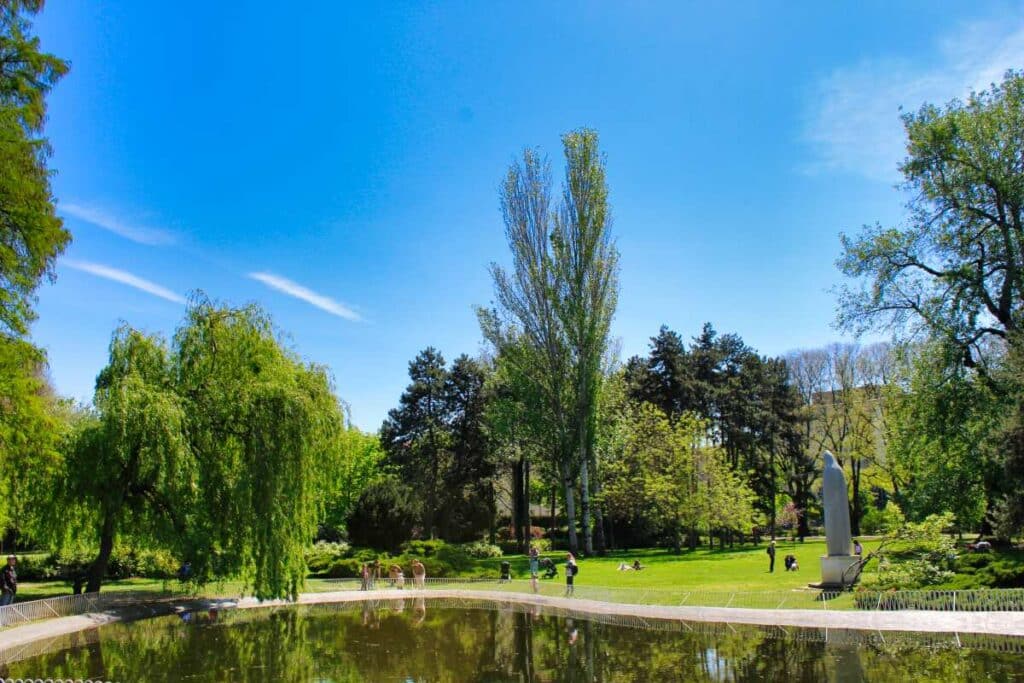
Danube Park (Dunavski Park)
Opposite the Museum of Vojvodina is the most beautiful park in the city. Like many other major projects in Novi Sad, it was initiated towards the end of the 19th century. Several monuments here commemorate important historical figures and mythical figures, but above all the Danube Park is a small oasis of peace and exudes a very special atmosphere with its pretty pavilion, pond populated by ducks and many benches. Over 600 trees provide shade, so it never gets too hot here, even at the height of summer.

Futoška Market (FutoškaPijaca)
If you want to immerse yourself in everyday Serbian life, then you should definitely visit the city’s most important market. It is located southwest of the old town. Many Serbs do their shopping not only in supermarkets, but also in markets like this. You can find everything you need for everyday life in the narrow alleyways of the market. In addition to food from local farmers, you can also find clothes, accessories and everything from toothpaste to washing powder that you would find in a modern supermarket. You can spend hours wandering around here, as there are over 400 stalls and a sea of smells and colors to explore.
Tip: After visiting the market, you should definitely stop by Jevrejska Street. This is where the old synagogue of Novi Sad is located. If you report to the security guard, you can get an insight into the magnificent house of worship, which was once the center of the Jewish quarter of Novi Sad, for 100 dinars.
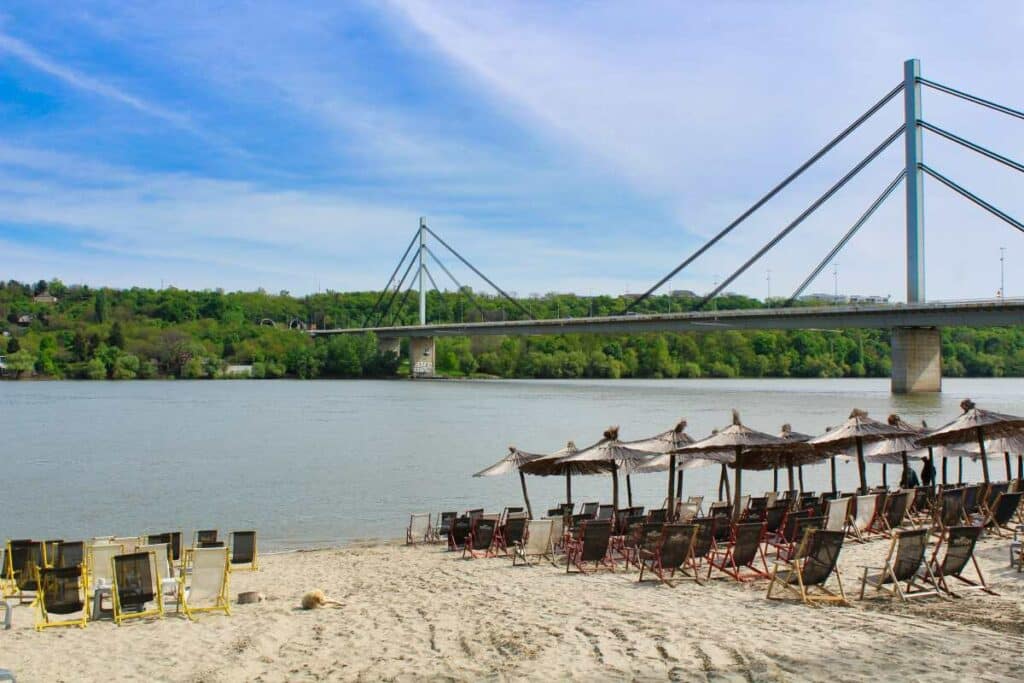
Quay (Kej) and Štrand
Now we leave the center and head to the banks of the Danube. Of course, the mighty Petrovaradin Fortress on the opposite bank is the first thing that catches your eye here, but you should definitely take a walk south along the bank. You will first come across an impressive memorial created by Jovan Soldatović, which commemorates the massacre of the local population by Hungarian fascists during the Second World War. If you follow the quay southwards, you will pass some outdoor fitness equipment and finally reach Štrand.
Štrand, whose unusual name dates back to Austrian times, is exactly what you would expect under this name. Here you can sunbathe on a deckchair, enjoy the wide range of gastronomic offerings and the view of Petrovaradin or go for a swim. But beware: the Danube is notorious for its unseen whirlpools. Your gaze inevitably falls on the remains of an old Danube bridge, a reminder of the bombing of the city by NATO. Just a stone’s throw from Štrand is the Fishermen’s Island (Ribarsko ostrovo), which is a little awkward to reach. There are several good restaurants serving fish dishes here.

Petrovaradin
Perhaps the most important of all Novi Sad sights and the city’s undisputed landmark is the mighty Petrovaradin or Peterwardein fortress perched on a rocky spur. The location above the river was already appreciated by settlers around 3000 BC. However, the area was only really developed under the Austrians, who built a huge defensive complex here between 1692 and 1780, at the foot of which a small town was built, which still looks today as if the soldiers had just gone for a walk down to the Danube.
The largest Austrian defensive position in the Balkans was built on 120 hectares, a bulwark against the threat of an Ottoman attack. The landmark of the complex is the White Clock Tower, from which you can enjoy a sensational view of the city. Food and drink are also catered for, with several terrace restaurants awaiting hungry and thirsty customers. There are also several art galleries and, above all, the city museum, which provides information about Novi Sad’s eventful past. The EXIT music festival, one of the most important in Europe, is also held here in summer.
Novi Sad Sights Book Tips
With this CityTrip from Reise Know-How Verlag, which also describes the most beautiful places in Belgrade, you are perfectly equipped to explore the most beautiful Novi Sad sights, but also to learn a lot about the country and its people. You’ll also get lots of interesting restaurant and shopping tips and be introduced to the city’s most exciting museums!
Wenn ihr euch näher mit der Geschichte von Novi Sad befassen wollt und nicht nur an den Novi Sad Sehenswürdigkeiten, sondern auch daran interessiert seid, wie aus einer österreichischen Verteidigungsstellung die vielleicht schönste Stadt Serbiens wurde, dann ist dieses Buch genau richtig für euch.
Serbia is considered one of the culinary hotspots in the Balkans. In this book, you will be introduced to the most delicious Serbian dishes (using beautiful photos), which you can then easily recreate at home.
- Petkovski, Tatjana (Author)
Do you want to look behind the facade of Novi Sad’s sights and are interested in Serbia’s eventful past? In this book of over 500 pages, you will learn everything about the period from the 19th century to the present day and gain a better understanding of the country and its inhabitants.
- ABIS_BUCH
- Sundhaussen, Prof. Dr. Holm (Author)
Serbian roads can sometimes be a challenge. Good thing there are maps from the World Mapping Project to help you travel safely and reach even the most remote places on your Balkan road trip.
- Peter Rump, Reise Know-How Verlag (Author)
How did you like the article on the most exciting Novi Sad sights? Let us know and write us a comment! Which places should we visit for you in the future? We are always happy to receive suggestions!


